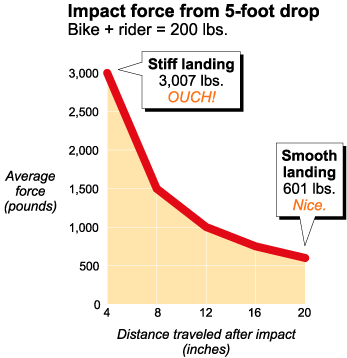More weight = harder landings
In the comments for “Can big riders jump?” someone asked about the effect of body weight on landing force. You know I love this stuff, so …
|
The more you click, the more I can post. Lee Likes Groceries dot com! |
— — —
Said Patrick:
Being a big guy who wants to jump better, I found Can big riders jump? to be an interesting article. I know that when I hit a jump or drop “right”, with correct body position and proper body english, that the jump feels almost effortless.
But I wonder about the other side of things…like when you have to land. How are the forces different for a heavy guy. If a 260lb rider drops 8′ to transition, how much greater are the forces (ground reaction forces, forces on the rider’s body/joints) than if a 160lb rider does the same drop? Of course, there are many other variables to consider, but assume we are using a hypothetical rider that is capable of gaining and losing 100lbs for our experiment, so rider skill (and bike) stay the same.
— — —

|
Hey Patrick,
Landing force is directly proportional to weight (aka mass). Twice as massive = twice as much landing force (everything else being equal).
If you land a 5-foot drop stiffly, you can easily damage your bike and body. To land smoothly, you must use your legs and suspension to spread the impact over the longest distance possible. The more leg travel you use, the smoother the landing. Check out the snappy chart: a smooth landing can be 1/5 as hard as a stiff landing.*
As you get bigger, you add pounds faster than you add height. So you endure more impact with relatively less leg travel.
For two riders with the same medium build (Body Mass Index** of 24)
| Height | Weight | Height in inches/weight |
| 5’6″ | 150lbs | 0.44 |
| 6’4″ | 200lbs | 0.38 |
Compared to the 5’6″ 150-pounder, the 6’4″ 200-pounder has about 16% less body suspension per pound. That translates into a noticeably harder landing.
If you simply gain 60 pounds, it gets way worse:
| Height | Weight | Height in inches/weight |
| 6’4″ | 200lbs | 0.38 |
| 6’4″ | 260lbs | 0.29 |
Compared to your medium self, your heavy self has 30% less body suspension per pound. That’s a big difference, whether the weight is fat or muscle. (But muscle is way more useful!)
Conclusion
If you’re a big rider:
– Minimize your weight. Especially fat.
– Get as strong a possible. Plyometrics help you handle impacts.
– Hone your technique. Use your entire range of motion.
You can argue with the math, but lean, strong and skilled always destroys fat, weak and sloppy.
— — —
*Read this: Drops: Don’t get bucked
**More about Body Mass Index: www.consumer.gov/weightloss/bmi.htm

Comments are closed.